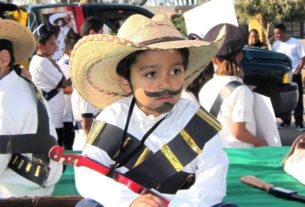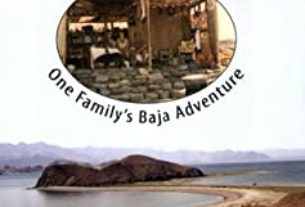When tourists visit tropical Mexico, they are sometimes invited to visit a coffee plantation. My invitation came when I was camping with my family near Aticama, a small village on the Nayarit coast, 10 miles south of the pleasant sea-side resort of San Blas and approximately 100 miles north of Puerto Vallarta.
Beyond the village of Aticama, the highway crosses a bridge over a sparkling, shallow river. Where the river meets the ocean, a grassy field adjoined an inviting sandy beach. As we approached, it looked to be a perfect camping spot so I asked a small group of youths if it was a suitable camp-site. They said that the spot was a local party place (as so many spots are in every country!) and advised us to ask the advice of Israel, a local man. With his excellent English and good-natured character, Israel considers himself a local ambassador to visiting tourists. He mentioned that there was a walled and crowded recreation vehicle campsite just another mile down the road. He invited us to stay at an ocean-side camp-site that he took care of for a business-man. We decided to view the spot. Moments later, a private well-groomed, park-like site appeared. It had tall coconut palms, banana and lemon trees laden with fruit. There was a large, shaded concrete pad with cooking and washing and bathing facilities. Pastel flowered hibiscus plants provided a garden vista while ocean waves lapped at the horizon.
It was perfect!
Israel included us on his daily visiting rounds. He would show up in the morning and again before dark to join us to laugh, visit or share a meal. He always walked barefoot and could silently appear in the camp-site before I could see him. Like many of his fellow countrymen, he had spent time away from Mexico, seeking work in the ‘north’. His travels had taken him and his sons all the way to the fruit orchards of Washington State. Perhaps because of his personal exposure to these cool lands, he was an emphatic host to us; the new tourists on the block! He worked seasonally in his village’s ejido lands: the surrounding plantations that are managed through a rural agricultural cooperative. Between these visits, we would spend time swimming, surfing, fishing and walking on the lovely beach. Young men would gallop horses along the shore at low tide. My oldest son spent hours surf casting and learning other fishing techniques from the local fishermen. Our camp-site was near a main walking path between villages, so often we would stroll in to a village for a few supplies.
After a few days, Israel invited us on a tour of the ejido lands. From our ocean-side camp-site, we crossed the highway and entered the dense, tropical plantations. The main banana crop had recently been harvested. The large, lush, broad-leafed plants would soon be cut to the ground. A single piece of stem with a large leaf would be pushed into the soil. Less than nine months later, the new banana tree would hang heavy with fruit again! The fruit that remained on the tree would soon fall to the ground and begin its decay. Israel encouraged us to pick our fill. Fresh fruit starved Canadians need not be asked twice! The children and ourselves gathered all the fresh avocados, papayas and bananas that we could carry back.
Several days later, Israel asked me if we would like to accompany him on a hike to visit a coffee plantation in the nearby tropical mountains. It was necessary to plan for an eight hour return hike. I packed appropriate food and enough water for the hike. The hike began by walking the packed dirt roads through the ejido plantations. Initially, the terrain was level but gradually the road began to rise and wind itself through gentle, jungle forested mountain foot-hills. As the grade of the dirt road increased, it became deeply rutted. Although it was the dry season, small creeks washed by and twinkled over the road. The surrounding jungle pressed close to the narrowing road. Israel put his ever ready machete to good use to keep the road clear.
Suddenly the jungle opened to reveal a small man-made lake. Israel explained that this lake was the source of drinking water for the village below. My eyes were caught by the sight of a whirling, twirling flock of large birds above the center of the lake. They were diving repeatedly Their blackness and long forked tails identified them as frigate birds, the notorious pirates of the tropical bird world. I had watched them pursue the other common sea-birds at the beach with great vigor until they forced the other birds to drop their catch. The frigate birds would swoop and unerringly retrieve the booty. Today, however, they were bathing and drinking in an aerobatics display.
Butterflies fluttered everywhere! They were large, small and colorful like floating sky gems. Israel asked me to guess their name in Spanish. I stretched my vocabulary in vain. “Mariposas!” he laughingly answered when I gave up guessing. Tiny bright green leaf flags marched across the road that had become more like a trail. “Leaf-cutting ants!” he stated as we continued the name game. I wondered at a towering, majestic tree pendulous with large green fruit. “Mangos!” he called out. A flock of small bright parrots flitted before me. A huge termite nest seethed from a rotted mango stump. This was the jungle!
It was nearing mid-day and I was thankful for the shade that the overhanging trees gave in the humid heat. The first sign of habitation in hours revealed a clearing with several thatched roof homes. It would be necessary to stop at the home of la Señora, the matriarch of this coffee plantation and to ask her permission to cross her family’s land. La Señora was sitting in the shade of her porch, rocking an infant child in a hammock. She rose graciously and extended her hand in greeting. Her hand appeared as parchment over bones and benevolence shone from her one-toothed smile. As my children took turns shaking her hand, I could tell that there was a look of wonder on their faces. Later they confessed that they could not believe that someone of such an ancient appearance could be shaking their hands with such vigor. She invited us all into her impeccably clean and simple home and asked her daughter-in-law to pour us all cool water in tall sparkling glasses. As her English was non-existent and my Spanish at a beginner’s level, we both relied on Israel as our interpreter. An amiable discussion followed, during which permission to cross her land was readily granted.
A short distance beyond the homes, the trail dropped down into a shady ravine. Under the canopy of jungle shade, the coffee bushes grew in abundance. Their green berries would be picked when a hint of red would signal their impending ripeness. Suddenly, without warning, two coffee sack-loaded mules, who were quickly climbing the slippery hill, faced me head-on. I scrambled off the trail to avoid head-on collision! Everyone else, behind me, dove madly into the bushes beside the trail. The mules hurried onward, followed closely by their drivers who also seemed surprised to see us! Brief greetings were exchanged, then the men hurried on to keep pace with those home-coming mules.
The sounds of nature from the jungle had been replaced by the sound of loud pulsating plantation sprinklers driven by a close-by water-fall. Down large slippery rocks, I climbed to reach the crystal-clear pools below. Soon everyone was splashing and swimming in those refreshing waters. As I floated in the sun-light waters, I gazed up into the lush tropical foliage of the Nayarit jungle. It was a tropical fantasy brought true to life!
For the return hike through the plantation, Israel chose a different path. Here, the jungle opened into a sunny glade with a large raised concrete platform in its center. Three men were busy raking millions of drying coffee beans by hand. One of the men with withered legs, dragged himself about with the muscles of his upper body to keep as busy as the others. Again, my children’s jaws dropped in amazement at a scene so different from their life in Canada.
The descending return hike went quickly. This was fortunate because darkness seems to fall as quickly in January in tropical Mexico as it does in wintry Canada. Soon only the winking lights of the fireflies would penetrate the jungle blackness. Back at our ocean-side campsite, a host of gaily-colored birds were feasting on the remains of our tropical fruit. As I eased myself into a deck-chair, I reflected on that enchanting jungle hike. In an environment so different from my known world, I felt that I had shared an everyday walk in a rural Mexican’s world.
I was to discover a few days later, that local advice is best accepted. Israel had warned us at the beginning of our stay at Aticama, to take precautions against petty thievery. So initially we took common sense preventative measures but after a week, we had relaxed our vigilance. One early evening after dark, all of our out-side camping gear disappeared. We decided to move along after that incident.
Still, if you get an offer to hike to a coffee plantation, do consider accepting it. You will probably have an excellent adventure! But watch out for coffee-bean carrying mules; they stop for no-one when returning home!



